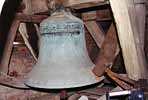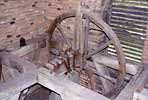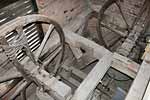For this church:    |
|
| Date | Inscription | Size | Weight | Founder | Note | Position | |
| 1 | Hung in 1698 - probably when the tower was rebuilt in brick | ‘God save his church. R Dubelday, I Bagulay Wardens 1698’ in one line round the haunch in Roman capitals with the initial ‘I’ in lombardic script |
just over 27 inches | about 3.5 cwt | William Noone of Nottingham | Treble bell, note of D | Hangs on the east side of the bell frame |
| 2 | Thought to date from between 1650-1725 but installed in Hawksworth church tower in 1858 | It has no inscription but 1858 is inscribed on the spokes of the wheel in Roman numerals as MDCCCLVIII |
nearly 31 inches | about 5 cwt | Unknown | C | Hangs on the west side of the bell frame |
| 3 | This bell strikes the hour and was hung in 1873 when the clock was presented by the Rector John Blurton Webb | ‘J Taylor & Co Founders Loughborough 1873’ in sans serif capitals round the haunch |
just over 38 inches | 10cwt | J Taylor of Loughborough | Tenor bell, note of A | Hangs on the south side of the bell frame |
 The bell which was The bell which washung in 1698 |
 The 1698 bell (front) The 1698 bell (front) and 1873 bell (back) showing the fittings |
 The bell wheel The bell wheel |
The bells are hung in a large wooden frame which could hold four bells. The frame dates from about 1800 and is an Elphick Type ‘V’design (Pickford Group 6.B). It sits on the belfry floor which is supported by four beams which run east to west and below them are two foundation beams running north to south. The fittings for each bell consist of a wooden headstock, iron grudgeons and plain bearings. The gear of the tenor bell dates from 1873 but that of the two lighter bells is earlier and probably around 1800.
The bells are hung for full circle ringing but they have not been rung for many years because the tower structure is not thought to be safe enough to do so. However, the bells are struck to form the chime for the clock. In 1995, the stability of the frame was tested and a report from The Southwell Diocesan Guild of Church Bell Ringers concluded that although there was some frame movement, especially when the tenor was swung, it was not excessive. In their opinion at that time, there was no reason why the bells should not be sounded by swing chiming them but they advised against ringing the bells full circle in their present state because of excess loadings on the frame when rung full circle. To restore the ring, the bells would require re-hanging with new fittings. With bracing the existing frame would appear to be strong enough to hold the ring and enable the bells to be rung full circle. The bells are currently out of tone with each other but by careful tuning they could be tuned as Numbers 1, 3 and 5 of a ring of five and the frame could hold a fourth bell. This major restoration project was put on hold in 1995 due to lack of sufficient funds, over and above the money that is constantly being raised in the village for repairs to the fabric and furnishings of the church.
 The bell frame The bell frame |






